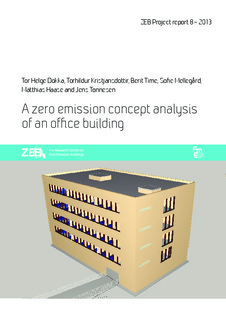| dc.contributor.author | Dokka, Tor Helge | |
| dc.contributor.author | Kristjansdottir, Torhildur | |
| dc.contributor.author | Time, Berit | |
| dc.contributor.author | Mellegård, Sofie Elisabet | |
| dc.contributor.author | Haase, Matthias | |
| dc.contributor.author | Tønnesen, Jens | |
| dc.date.accessioned | 2016-02-12T12:46:40Z | |
| dc.date.accessioned | 2016-02-19T07:41:16Z | |
| dc.date.available | 2016-02-12T12:46:40Z | |
| dc.date.available | 2016-02-19T07:41:16Z | |
| dc.date.issued | 2013 | |
| dc.identifier.isbn | 978-82-536-1323-9 | |
| dc.identifier.isbn | 978-82-536-1325-3 | |
| dc.identifier.issn | 1893-157X | |
| dc.identifier.issn | 1893-1561 | |
| dc.identifier.uri | http://hdl.handle.net/11250/2379620 | |
| dc.description.abstract | The main aim of the work has been to do modeling and calculations of the energy use, embodied emission and the total CO2-emissions for a typical Norwegian office building. The goal is to find the most important parameters in the design of a zero emission office building, according to the current ZEB definition.
The preliminary conclusions from this study are:
1. For a typical medium raise office building (4 storey) it is rather easy to achieve a ZEB-O (Operation) level, which in this case can be labeled a zero energy office building (energy produced on-site with PV equals total electricity demand).
2. Taking into account also the embodied emissions from materials and installations it seems very difficult to achieve the ZEB-OM (Operation and Material) level. The calculation is based on using areas with "acceptable" solar yield, namely the roof and the south (long) façade.
3. Even if the calculation of embodied emission (EE) has considerable uncertainties, preliminary results indicate that EE is considerable higher than the emission related to operational energy use. However, this is based on traditional design and material use of a Norwegian office building. A more optimized building with regard to low carbon materials, could change the balance between operational- and embodied emissions.
4. To achieve a ZEB-OM level a combination of further reduced energy demand, high performance thermal supply systems, reduced embodied emissions and increased PV-production seems to be the solution. | |
| dc.language.iso | eng | |
| dc.publisher | SINTEF Academic Press | |
| dc.relation.ispartofseries | ZEB Project report;8 | |
| dc.subject | Zero emission building | |
| dc.subject | Office concept building | |
| dc.subject | Delivered energy | |
| dc.subject | Embodied energy | |
| dc.subject | Green house gas | |
| dc.title | A zero emission concept analysis of an office building | |
| dc.type | Research report | |
| dc.date.updated | 2016-02-12T12:46:40Z | |
| dc.description.version | publishedVersion | |
| dc.rights.holder | © 2013 SINTEF Academic Press and Norwegian University of Science and Technology | |
| dc.subject.nsi | VDP::Technology: 500 | |
| dc.identifier.cristin | 1034307 | |
